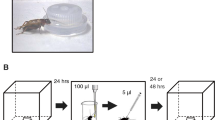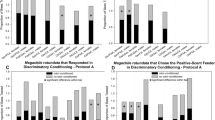Abstract
A classical conditioning approach was used to examine the ability of Culex quinquefasciatus Say (Diptera: Culicidae) to associate odor with a sugar-meal of varying quality. The objectives of this study were to investigate the impact of different sucrose concentrations (5 %, 10 %, or 50 %) on positive response to conditioning and to examine sucrose concentration preference following exposure to a 10 % solution. Mosquitoes conditioned in conjunction with all three sucrose concentrations showed evidence of learning; including the concentration of the conditioning stimulus, and the sex of the mosquito. Using colored solutions to determine feeding patterns of experienced mosquitoes indicated male mosquitoes showed no preference but females showed a preference for 10 % over 5 % sucrose but not between 10 % and 50 % sucrose solutions.









Similar content being viewed by others
References
Allan SA, Bernier UR, Kline DL (2006) Laboratory evaluation of avian odors for mosquito (Diptera: Culicidae) attraction. J Med Entomol 43:225–231
Alonso WJ, Schuck-Paim C (2006) The ‘ghosts’ that pester studies on learning in mosquitoes: guidelines to chase them off. Med Vet Entomol 20:157–165
Alonso WJ, Wyatt TD, Kelly DW (2003) Are vectors able to learn about their hosts? a case study with Aedes aegypti mosquitoes. Mem Inst Oswaldo Cruz 98:665–672
Awono-Ambene HP, Diawara L, Robert V (2001) Comparison of direct and membrane feeding methods to infect Anopheles arabiensis with Plasmodium falciparum. AmJTrop Med Hyg 64:32–34
Baker HG (1975) Sugar concentrations in nectars from hummingbird flowers. Biotropia 7:37–41
Beier J, Müller G, Gu W, Arheart K, Schlein Y (2012) Attractive toxic sugar bait (ATSB) methods decimate populations of Anopheles malaria vectors in arid environments regardless of the local availability of favoured sugar-source blossoms. Malar J 11:31
Bitterman ME, Menzel R, Fietz A, Schafer S (1983) Classical conditioning of proboscis extension reflex in honeybees (Apis mellifera). J Comp Psychol 97:107–119
Brantjes NBM, Leemans JAAM (1976) Silene otites (Caryophyllaceae) pollinated by nocturnal Lepidoptera and mosquitoes. Acta Biol Neerl 25:281–295
Charlwood JD, Graves PM, Marshall TFDC (1988) Evidence for a ‘memorized’ home range in Anopheles farauti females in Papua New Guinea. Med Vet Entomol 2:101–108
Chilaka N, Perkins E, Tripet F (2012) Visual and olfactory associative learning in the malaria vector Anopheles gambiae sensu stricto. Malar J 11:27
DeMaris A (1995) A tutorial in logistic regression. J Marriage Fam 57:956–968
Foster WA (1995) Mosquito sugar feeding and reproductive energetics. Annu Rev Entomol 40:443–474
Foster WA (2008) Phytochemicals as population sampling lures. J Am Mosq Control Assoc 24:138–146
Fradin MS, Day JF (2002) Comparative efficacy of insect repellents against mosquito bites. N Engl J Med 347:13–18
Gerberg EJ, Barnard DR, Ward RA (1994) Manual for mosquito rearing and experimental techniques. Am Mosq Control Assoc Bull 5:102
Gorham JR (1976) Orchid pollination by Aedes mosquitoes in Alaska. Am Midl Nat 95:208–210
Jhumur US, Dotterl S, Jurgens A (2006) Naive and conditioned responses of Culex pipiens pipiens biotype molestus (Diptera: Culicidae) to flower odors. J Med Entomol 43:1164–1170
Kevan PG, Tikhmenev EA, Usui M (1993) Insects and plants in the pollination ecology of the boreal zone. Ecol Res 8:247–267
Kim S, Choochote W, Jitpakdi A, Junkum A, Park S, Min G (2003) Establishment of a self-mating mosquito colony of Anopheles sinensis from Korea. Korean J Entomol 33:267–271
Knab F (1907) Mosquitoes as flower visitors. J N Y Entomol Soc 15:215–219
Laloi D, Sandoz JC, Picard-Nizou AL, Marchesi A, Pouvreau A, Tasei JN, Poppy G, Pham-Delegue MH (1999) Olfactory conditioning of the proboscis extension in bumble bees. Ent Exp Appl 90:123–129
Lindh JM, Terenius O, Eriksson-Gonzales K, Knolls BGJ, Faye I (2006) Re-introducing bacteria in mosquitoes—a method for determination of mosquito feeding preferences based on coloured sugar solutions. Acta Trop 99:173–183
Manda H, Gouagna LC, Nyandat E, Kabiru EW, Jackson RR, Foster WA, Githure JI, Beier JC, Hassanali A (2007) Discriminative feeding behaviour of Anopheles gambiae s.s. on endemic plants in western Kenya. Med Vet Entomol 21:103–111
McCall PJ, Kelly DW (2002) Learning and memory in disease vectors. Trends Parasitol 18:429–433
McCall PJ, Mosha FW, Njunwa KJ, Sherlock K (2001) Evidence for memorized site-fidelity in Anopheles arabiensis. Trans R Soc Trop Med Hyg 95:587–590
Molaei G, Andreadis TG, Armstrong PM, Bueno R Jr, Dennett JA, Real SV, Sargent C, Bala A, Randle Y, Guzman H, Travassos da Rosa A, Wuithiranyagool T, Tesh RB (2007) Host feeding pattern of Culex quinquefasciatus (Diptera: Culicidae) and its role in transmission of West Nile Virus in Harris County. Tex Am J Trop Med Hyg 77:73–81
Müller G, Schlein Y (2006) Sugar questing mosquitoes in arid areas gather on scarce blossoms that can be used for control. Int J Parasitol 36:1077–1080
Müller G, Beier J, Traore S, Toure M, Traore M, Bah S, Doumbia S, Schlein Y (2010a) Successful field trial of attractive toxic sugar bait (ATSB) plant-spraying methods against malaria vectors in the Anopheles gambiae complex in Mali, West Africa. Malar J 9:210
Müller GC, Junnila A, Qualls W, Revay EE, Kline DL, Allan S, Schlein Y, Xue RD (2010b) Control of Culex quinquefasciatus in a storm drain system in Florida using attractive toxic sugar baits. Med Vet Entomol 24:346–351
Müller GC, Xue R-D, Schlein Y (2011) Differential attraction of Aedes albopictus in the field to flowers, fruits and honeydew. Acta Trop 118:45–49
Nasci RS, Savage HM, White DJ, Miller JR, Cropp BC, Godsey K, Lanciotti RS (2001) West Nile Virus in overwintering Culex mosquitoes, New York City, 2000. Emerg Infect Dis 7:1–3
Pankiw T, Waddington KD, Page RE Jr (2001) Modulation of sucrose response thresholds in honey bees (Apis mellifera L.): influence of genotype, feeding, and foraging experience. J Comp Physiol A 187:293–301
Randich A, LoLordo VM (1979) Associative and nonassociative theories of the UCS preexposure phenomenon: implications for Pavlovian conditioning. Psychol Bull 86:523–548
Renshaw M, Service MW, Birley MH (1994) Host finding, feeding patterns and evidence for a memorized home range of the mosquito Aedes cantans. Med Vet Entomol 8:187–193
Ribbands CR (1949) Studies on the attractiveness of human populations to Anophelines. Bull Entomol Res 40:227–238
Sanford MR (2010) Associative learning capabilities of adult Culex quinquefasciatus Say and other mosquitoes. Ph.D., Texas A&M University College Station
Sanford MR, Tomberlin JK (2011) Conditioning individual mosquitoes to an odor: sex, source and time. PLoS One 6:e24218
SPSS, Inc. (2005) SPSS for windows, release 14.0.1 computer program, version 14.0. Chicago, IL, USA
SPSS, Inc. (2007) SPSS graduate pack 16.0 for windows computer program, version 16.0.1. Chicago, IL, USA
Thein LB (1969) Mosquito pollination of Habenaria obtusata (Orchidaceae). Am J Bot 56:232–237
Thom C, Guerenstein PG, Mechaber WL, Hildebrand JG (2004) Floral CO2 reveals flower profitability to moths. J Chem Ecol 30:1285–1288
Tomberlin JK, Rains GC, Allan SA, Sanford MR, Lewis WJ (2006) Associative learning of odor with food- or blood-meal by Culex quinquefasciatus Say (Diptera: Culicidae). Naturwissenschaften 93:551–556
Wäckers F, Bonifay C, Vet LEM, Lewis J (2006) Gustatory response and appetitive learning in Microplitis croceipes in relation to sugar type and concentration. Anim Biol 56:193–203
Acknowledgments
We wish to thank Sandy Allan and Erin Vrzal of the Center for Medical, Agricultural, and Veterinary Entomology, USDA-ARS, Gainesville, FL, USA for providing us with mosquitoes, Thoris Greene and Glen Rains of the Department of Biological and Agricultural Engineering, University of Georgia, Tifton Campus, GA, USA for their technical assistance, Roberto Gorena of the Mosquito Control Division of the Harris County Public Health and Environmental Services, Houston, TX, USA for statistical advice and useful comments on an earlier draft of this manuscript. We also thank Mark Johnsen for his useful discussions and comments, which greatly improved this manuscript. The James Gus Foyle Memorial Scholarship from the Texas Mosquito Control Association and the Regents Fellowship from Texas A&M University provided funding support. This study was conducted in partial fulfillment of a doctoral degree to M. R. S.
Author information
Authors and Affiliations
Corresponding author
Rights and permissions
About this article
Cite this article
Sanford, M.R., Olson, J.K., Lewis, W.J. et al. The Effect of Sucrose Concentration on Olfactory-Based Associative Learning in Culex quinquefasciatus Say (Diptera: Culicidae). J Insect Behav 26, 494–513 (2013). https://doi.org/10.1007/s10905-012-9368-y
Revised:
Accepted:
Published:
Issue Date:
DOI: https://doi.org/10.1007/s10905-012-9368-y




